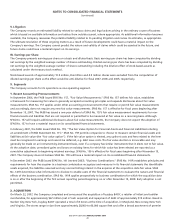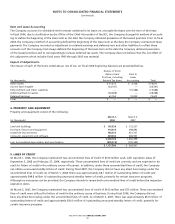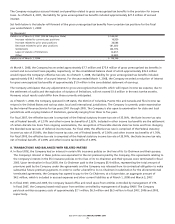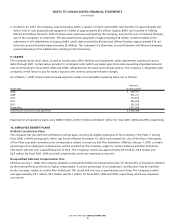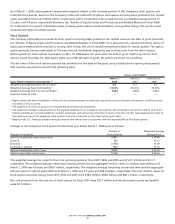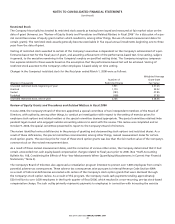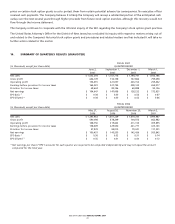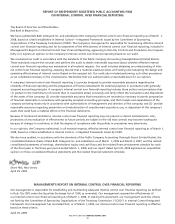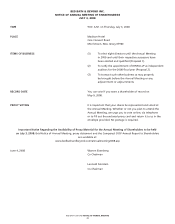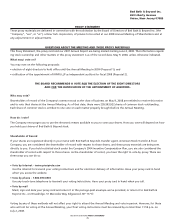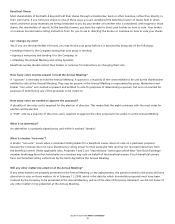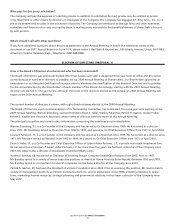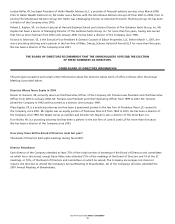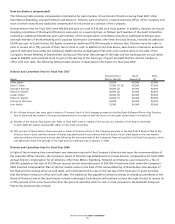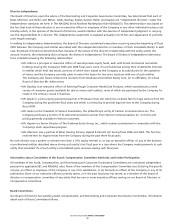Bed, Bath and Beyond 2007 Annual Report Download - page 32
Download and view the complete annual report
Please find page 32 of the 2007 Bed, Bath and Beyond annual report below. You can navigate through the pages in the report by either clicking on the pages listed below, or by using the keyword search tool below to find specific information within the annual report.
BED BATH& BEYOND ANNUAL REPORT 2007
30
Restricted Stock
The Company historically has treated its restricted stock awards as having been issued and measured at fair market value on the
date of grant (however, see “Review of Equity Grants and Procedures and Related Matters in Fiscal 2006” for a discussion of a spe-
cial committee review of equity grant matters which resulted in, among other things, the use of revised measurement dates for
certain grants). The restricted stock awards generally become exercisable in five equal annual installments beginning one to three
years from the date of grant.
Vesting of restricted stock awarded to certain of the Company’s executives is dependent on the Company’s achievement of a per-
formance-based test for the fiscal year of grant, and assuming achievement of the performance-based test, time vesting, subject,
in general, to the executive remaining in the Company’s employ on specified vesting dates. The Company recognizes compensa-
tion expense related to these awards based on the assumption that the performance-based test will be achieved. Vesting of
restricted stock awarded to the Company’s other employees is based solely on time vesting.
Changes in the Company’s restricted stock for the fiscal year ended March 1, 2008 were as follows:
Weighted Average
Number of Grant-Date
(Shares in thousands) Restricted Shares Fair Value
Unvested restricted stock, beginning of year 1,931)$ 37.25
Granted 1,174)39.32
Vested (181) 37.85
Forfeited (158) 37.93
Unvested restricted stock, end of year 2,766)$ 38.05
Review of Equity Grants and Procedures and Related Matters in Fiscal 2006
In June 2006, the Company’s Board of Directors appointed a special committee of two independent members of the Board of
Directors, with authority, among other things, to conduct an investigation with respect to the setting of exercise prices for
employee stock options and related matters as the special committee deemed appropriate. The special committee retained inde-
pendent legal counsel who engaged outside accounting advisors to assist with the review. This review was completed and on
October 9, 2006, the special committee presented its report to the Company’s Board of Directors.
The review identified various deficiencies in the process of granting and documenting stock options and restricted shares. As a
result of these deficiencies, the special committee recommended, among other things, revised measurement dates for certain
stock option grants. The exercise price for most of these stock option grants was less than the fair market value of the Company’s
common stock on the revised measurement date.
As a result of these revised measurement dates, and the correction of various other errors, the Company determined that it had
certain unrecorded non-cash equity-based compensation charges related to fiscal years prior to 2006. (See “Staff Accounting
Bulletin No. 108, Considering the Effects of Prior Year Misstatements When Quantifying Misstatements in Current Year Financial
Statements,” Note 3).
The Company’s Board of Directors also approved a remediation program intended to protect over 1,600 employees from certain
potential adverse tax consequences. These adverse tax consequences arise pursuant to Internal Revenue Code Section 409A
as a result of historical deficiencies associated with certain of the Company’s stock option grants that were disclosed through
the Company’s stock option review. As a result of this program, the Company made cash payments totaling approximately
$30.0 million to over 1,600 employees in the fourth quarter of fiscal 2006, which resulted in a non-recurring, pre-tax stock-based
compensation charge. The cash outlay primarily represents payments to employees in connection with increasing the exercise
NOTES TO CONSOLIDATED FINANCIAL STATEMENTS
(continued)


